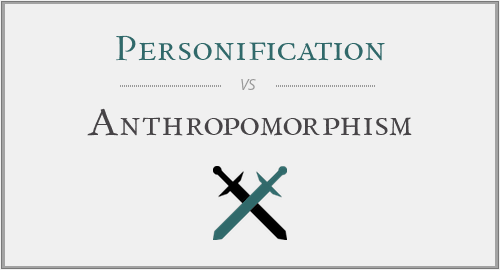
Do you know the difference between Personification vs Anthropomorphism?
Personification and anthropomorphism are two kinds of literary devices that are used to give depth and emotion to our descriptions.
In this article, Personification vs Anthropomorphism, we will compare and contrast these two techniques, showing how personification is figurative and anthropomorphism is literal.
At the very end the article, we have provided a short quiz which will further define the differences between these two words.
What is Personification?
Personification describes the act of giving human attributes to non-human objects, phenomena, and concepts in order to express meaning.
Personification is literary tool. It is metaphorical and uses figurative language to convey meaning; that is, its words and phrases are descriptive and emotional but are not literally true.
Personification is often used to add character to something that is inherently neutral; it allows an object to have a temperament, to have feelings, intentions, and motives, to be a “he” or a “she” rather than an “it.”
For example:
• We might remember a time when that “gallon of chocolate ice cream looked invitingly at us from its place on the table.”
Although a wind cannot howl, we understand the wind better because we humans howl, and we understand the sound of a howl.
It is impossible for a bowl of ice cream to look at us invitingly; it does not have eyes. But we understand the attraction of ice cream because we understand how someone’s eyes can draw us nearer. Through personification, we become more emotionally connected to the image.
In our daily life, we use personification in our speech and in our communication. We often find examples of personification in the books we read and in the movies we see.
What is Anthropomorphism?
Anthropomorphism is a literary device that transforms animals, objects, and concepts into human-like entities who literally behave like humans, have human characteristics, and have human emotions.
For example:
• A possum might be conversing at a dinner party and a tree might have a cold and be resting in bed.
In our daily life, we most often find anthropomorphism in stories, children’s books, poetry, and movies; it is a device employed by writers to create characters that the audience can understand and feel connected to.
Comparing Personification and Anthropomorphism
Both personification and anthropomorphism give human qualities to non-human things, and both literary devices are used to create deeper, more vivid characters and description.
Personification is figurative and anthropomorphism is literal.
Using personification, we might say that our electronic devices hate us. We would be speaking figuratively, using a “figure of speech”; our electronic devices are not, of course, capable of hatred because they are not human.
If we portray our smart phone with a mouth and eyes, and it literally stands upright on our desk and lectures us about social media, then we have transformed that smart phone into a human-like creature; that is anthropomorphism at work.
Take Our Quiz:
Questions:
2. It was delightful how the lion proposed marriage to the lioness. (Personification or Anthropomorphism?)
Answers:
3. Anthropomorphism: When the salt skips, it is literally acting like a person.




Have a discussion about this article with the community:
Report Comment
We're doing our best to make sure our content is useful, accurate and safe.
If by any chance you spot an inappropriate comment while navigating through our website please use this form to let us know, and we'll take care of it shortly.
Attachment
You need to be logged in to favorite.
Log In